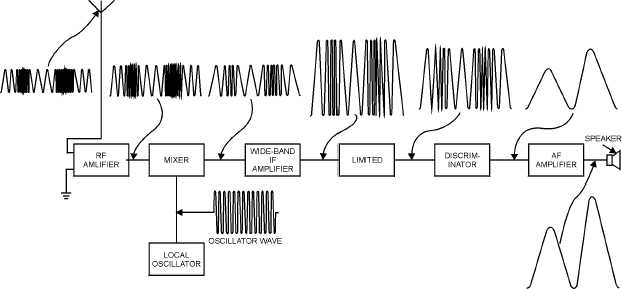2-13
combines the incoming rf with the local oscillator signal to produce the intermediate frequency, which is
then amplified by one or more IF amplifier stages. You should note that the fm receiver has a wide-band
IF amplifier. The bandwidth for any type of modulation must be wide enough to receive and pass all the
side-frequency components of the modulated signal without distortion. The IF amplifier in an fm receiver
must have a broader bandpass than an AM receiver.
Figure 2-10.—Block diagram of an fm receiver and waveforms.
Sidebands created by fm differ from the AM system. You should recall that the AM system consists
of a single set of side frequencies for each radio-frequency signal modulated. An fm signal inherently
occupies a wider bandwidth than AM because the number of extra sidebands that occur in an fm
transmission is directly related to the amplitude and frequency of the audio signal.
You should observe that only two fundamental sections of the fm receiver are electrically different
from the AM receiver. These are the discriminator (detector) and the limiter.
Beyond the IF stage, the two receivers have a marked difference. AM demodulation involves the
detection of variations in the amplitude of the signal; fm demodulation is the process of detecting
variations in the frequency of the signal. In fm receivers a DISCRIMINATOR is a circuit designed to
respond to frequency shift variations. A discriminator is preceded by a LIMITER circuit, which limits all
signals to the same amplitude level to minimize noise interference. The audio frequency component is
then extracted by the discriminator, amplified in the af amplifier, and used to drive the speaker.
ADVANTAGES.—In normal reception, fm signals are almost totally absent of static while AM
signals are subject to cracking noises and whistles. Fm followed AM in development and has the
advantage of operating at a higher frequency where a greater amount of frequencies are available. Fm
signals provide much more realistic sound reproduction because of an increase in the number of
sidebands. This increase in the number of sidebands allows more of the original audio signal to be
transmitted and, therefore, a greater range of frequencies for you to hear.
As you can see, fm requires a wide bandpass to transmit signals. Each transmitting station must be
assigned a wide band in the fm frequency spectrum. During fm transmissions, the number of significant


